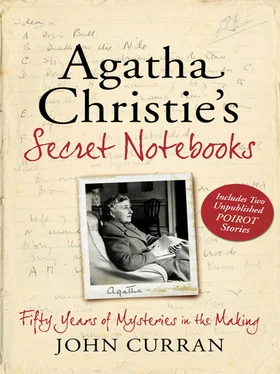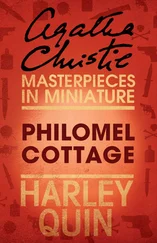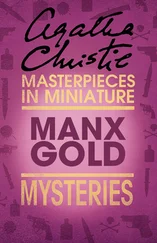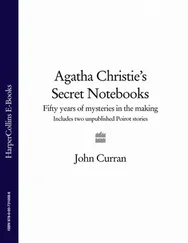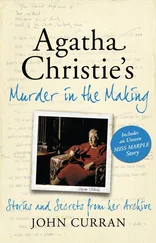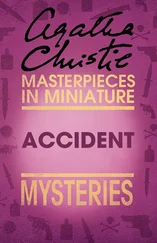‘The Augean Stables’
The fifth Labour presents Poirot with one of the most unusual cases of his entire career.
The plot for this story—involving some elements from Christie’s preliminary notes, though not the ‘dead body’—is summarised in Notebook 62:
Hercule Poirot and Prime Minister—P looks at him—as old Scotch chemistry Professor has said he’s a good man. P explains why Dagmar always hated her father—clean up the Augean stables—P sees Mrs NP—still beautiful woman—her reaction—P says certain cryptic things to her.
P and Dashett (young newspaper man)—says you have to turn the Thames and wash out Houses of Parliament. Sydney Cox—editor of This Week’s Garbage—nasty little man—HP comes to them—pleads—threatens—finally begs. Paragraph—The Honey Bee—in Little Bedchester—in the Tube—Mrs NP leaves London for Scotland. Libel trial—Miss Greta Handersohn—a waitress in a café in Copenhagen—approached by a journalist. P says a very old idea—Queen’s Necklace—to discredit Marie Antoinette.
This story follows the notes very closely, but there is one puzzling feature—the use of the initials ‘NP’ throughout in reference to the Prime Minister. There is no equivalent in the story, where the Prime Minister is Edward Ferrier. Although it is an enjoyable story with an inspired symbolism, it is one that is in the highest degree unlikely both in the mechanics of the story and in its outcome. One can’t help wondering if Christie’s unpleasant experiences in the aftermath of her 1926 disappearance were, to some degree, responsible for this swipe at the tabloid newspaper industry. This case is mentioned in the ‘Maids in the Kitchen’ chapter of One, Two, Buckle My Shoe when Poirot refers to it as ‘ingenious’.
‘The Stymphalean Birds’
A good deed has horrifying consequences for an innocent abroad.
The first attempt at this story, with its domestic setting, does not figure at all in the published version although it is possible to discern the germ of the subsequent idea—two women, an abusive husband, a young man emotionally blackmailed into helping:
Mrs Garland and Mrs Richardson—latter married—terrified of husband—latter gets a gun out—young woman parks herself in Gary’s apartment—he is young, married, a solicitor. Husband comes and browbeats him—threatens divorce—a womanish creature—Or—mother pleads also—an aging creature
A second outline, however, is followed almost exactly with Poirot making a very belated appearance in just the last four pages. The change of setting to a fictional foreign country, Herzoslovakia (scene of The Secret of Chimneys) , is in keeping with many of the other Labours:
Harold—his friendship with Nora Raymond—two women—Poles—look like birds. Her husband is studying architecture—her mother—worried—anxious. She comes into his room—for help—husband rushes in—swings something at her—she dodges—rushes out—man rushes after her—into her room—she fires—he falls—she gets him out of room—someone might come. Mother comes—says he’s dead. Advices [sic] HP—he speaks to him—or—hotel manager—kept quiet—he goes out and wires for money—gives it to them—police come—everything hushed up—then mother in agony again—the women in room next door have heard
Even here, though, there are differences. In the published version there is no mention of Nora Raymond and a paperweight achieves the ‘death’, not the gun suggested by the notes (‘she fires—he falls’). This change makes sense; the story is set in a hotel, and a gunshot in such a location would have attracted attention and made the plot unworkable.
‘The Cretan Bull’
Is Poirot’s seventh Labour merely a case of bad heredity or is it something more sinister?
There are relatively few notes about the seventh Labour, ‘The Cretan Bull’. The main problem seems to have been the choice of poison—Christie finally settled on atropine (also the poison of choice in ‘The Thumb Mark of St Peter’ from The Thirteen Problems). The story shares an untypical emphasis on blood—the ‘mad killer’ idea—with ‘The Erymanthian Boar’. But as in other Christie titles— Hercule Poirot’s Christmas and ‘The Importance of a Leg of Mutton’ from The Big Four, for example—this is an important part of the plot:
P asked down—country squire and old friend fear that squire’s boy is mad—madness in family—boy has been in Navy—(got out of that)—squire never got over wife’s death—boating accident or car accident—
(Does HP enquire about that as though he thinks car had been tampered with by crony? Wife only with him by afterthought says husband—asked, friend blusters—said first he had heard of that—make him sound suspicious. Boy marvellously handsome—girl there in love with him—he himself believes he is mad. Drug—eyes? Scopolamine—hyoscyamine—atropine—or aconite—ointment smeared on—hallucinations. Final attempt to kill girl
This story shares a plot device with A Caribbean Mystery and is in fact referenced during the plotting of the later novel. The most interesting few words in the above extract are undoubtedly ‘make him sound suspicious’. This was the strategy on which Christie built her career—the presentation of a story in such a way as to make the innocent seem guilty and vice versa. Few people reading this story will not single out George Frobisher as the villain of the piece, which is exactly what Christie intended.
‘ The Horses of Diomedes’
Poirot tackles the scourge of drug-pushers.
There are two distinct sets of notes for this eighth Labour. Despite the fact that Notebook 44 contains the ‘correct’ notes for most of the other Labours, the relevant notes for this story are those from Notebook 62:
P on trail of drug racket—County place—(not county)—rich manufacturers etc—
Old General Boynton—Gout—choleric—swollen leg. Daughters—wild girls—one gets herself into a mess—not daughter at all?
Gang—Old Boy the head of the racket—Girls turn on him
Stillingfleet—calls on Poirot—the drug racket—turns decent people into wild beasts—you asked me to keep my eyes open—girl in a fire—mews—hashish—he got girl out of it. The other sister—used to be decent kids—father an Old General. P sees them—sullen girl—hard boiled—says Stillingfleet is a good sort. P says will look her father up—look of alarm in her eyes—P says will be discreet. S[tillingfleet] and P—says very young—18—damned shame they aren’t better looked after—P goes down to Norfolk—the General—Gout—temper—worried about his girls. P says: Who are their friends?
Dalloway—man like a horse—slow etc.—Mrs Larkin—at her house P sees the others—dartboard etc.—
Hylda—vague girl—Cummings—young doctor—assistant to older man—sandwich box (belonging to Dalloway) in hall—P gets note (look in S. Box)—he does
There are a few minor changes—Dr Stillingfleet (possibly of ‘The Dream’ and Third Girl) changes to Dr Stoddart, the sandwich box becomes a hunting flask and there is no mention of a dartboard.
There are notes in Notebook 44 relating to this story, but they present different, and in one case, rather outlandish speculations:
The Mares of Diomedes
Old racing man—his ‘gals’ very wild—what can P do?—Bloomsbury—one of them shoots someone—(Mrs Barney?)—unlike twin idea—woman servant one of them—NO!!
OR
P pays a young man to be ‘killed’ by one of them—Or—Secret service—Jacinta?
Читать дальше
Конец ознакомительного отрывка
Купить книгу
